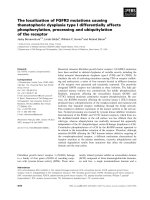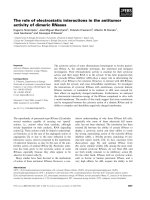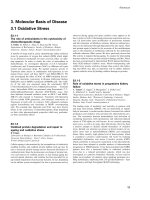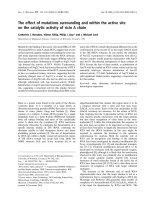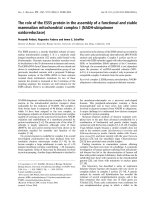Báo cáo khoa học: "The "Spectrum" of Weak Generative Powers of Grammars" ppt
Bạn đang xem bản rút gọn của tài liệu. Xem và tải ngay bản đầy đủ của tài liệu tại đây (199.43 KB, 5 trang )
[Mechanical Translation and Computational Linguistics, vol.9, no.1, March 1966]
The "Spectrum" of Weak Generative Powers of Grammars
by Wayne A. Lea, Research Laboratory of Electronics,
Massachusetts Institute of Technology, Cambridge
A summary is presented of some results in the literature concerning the
generative powers of various formal grammars. The relative generative
powers are displayed graphically.
I. Introduction
Many forms of grammars have been proposed in the
study of such related language problems as mechanical
translation, computer languages, mathematical linguis-
tics, and the more general characterizations of natural
languages. It is thus interesting to inquire about the
relationships between such grammars. In particular,
one might ask which proposed grammars are the “most
powerful” (in some meaningful sense) and which are
the most accurate characterizations of natural-language
phenomena.
In this paper, grammars will be compared on the
basis of the possible symbol sequences they may pro-
duce—that is, on the basis of what has been called
their “weak generative powers.” The relationships will
be displayed on a “spectrum” of weak generative
powers of grammars. It is hoped that this concise
graphical display will be found an illuminating and
useful comparative summary of grammars, generated
languages, and equivalent machines.
No attempt will be made to explain in any detail the
various grammars and machines listed in this paper,
nor will the relationships discussed be proven, since
they have already been considered in detail in various
published papers. We shall merely consider a brief
listing of each grammar, language, or machine type,
and references where each relationship to other gram-
mars, languages, and machines is shown. In listing
references, our purpose is not to acknowledge the origi-
nal developers of each interrelationship but, rather
only to provide references where demonstrations of
such relationships can be found. Although the author
does not profess to have checked that all summarized
results are valid, the literature indicates that they are.
More important, the use of the chosen form of display
clarifies any stated relationships between various formal
grammars and proposed grammars of natural lan-
guages.
* This paper is a revision of a memorandum written in June, 196.5,
when the author was affiliated with the Mechanical Translation Group
of the Research Laboratory of Electronics, Massachusetts Institute
of Technology. The author acknowledges the co-operation and en-
couragement of several members of that group, including its director,
Victor Yngve. The help of G. H. Matthews in providing references
and reviewing early drafts of the paper is also acknowledged. This
work was supported in part by the National Science Foundation
(grant GN-244) and in part by the Joint Services Electronics Pro-
gram under contract DA36-039-AMC-03200(E).
Thus, our goals are: (1) the listing of references
where relationships between grammars, languages, and
machines are presented and (2) the handy pictorial
presentation (in a single “spectrum”) of the relative
weak generative powers of such grammars and their
corresponding machines and resulting languages.
Though it is hoped that this listing and display of
grammars will be in some sense exhaustive of known
results, some possible grammar types may have been
missed. One advantage of the spectrum display used
herein (Fig. 1) is that such additions can be easily re-
lated to known grammars by simply marking them at
the appropriate positions on the spectrum.
There are some known grammars whose relation-
ships to other grammars are as yet unknown. The
"branching" of the spectrum of Figure 1 will illustrate
these uncertain relationships and thus indicate several
unsolved problems in algebraic linguistics.
II. Languages, Grammars, and Machines
In combinatorial systems (see reference 1 or 2) and
formal linguistic theory (reference 3, chap, iv), a
language is simply a set of sequences or strings pro-
duced by concatenation of elements out of some finite
vocabulary, set V
T
. A grammar G is then a set of rules
(or “productions”) for enumerating the strings belong-
ing to the language. A grammar may be precisely de-
fined as a 4-tuple (V, V
A
, S, P), where V is a finite
non-empty vocabulary, V
A
(called the auxiliary vocabu-
lary) is a non-empty subset of V (and represents the
symbols or phrase categories used at intermediate steps
in the generation of a string), S (the axiom, or initial
string) is a member of V
A
, and P is a finite set of pro-
ductions which yield strings in the terminal vocabulary
(V
T
= V — V
A
) by substitutions starting with the
axiom S. The language L generated by G is a subset of
the free monoid V
T
* generated by concatenating mem-
bers of V
T
. Terminal strings (members of L) are pro-
duced by derivations consisting of finite sequences of
applications of the productions of G, starting from
axiom S. A production of string ψ from string φ will be
symbolized as φ → ψ, while a derivation of ψ from φ
is symbolized as φ ⇒ ψ.
To restrict the languages generated by grammars to
interesting proper subsets of the free monoid V
T
*, it
is necessary to restrict the form of productions allowed.
10
The broadest generative power of interest in mathe-
matical linguistics is the power of a general Turing ma-
chine. Since Turing machines are associated with all
effectively computable functions or algorithms,
3
broader
generative power would involve sets which could not
even be effectively (i.e., mechanically) enumerated.
III. The Spectrum
We shall now consider how the weak generative
powers of various grammars and machines are related.
Grammars are considered to be weakly equivalent when
they produce the same language. Types of grammars
are thus equivalent if for each language produced by
a grammar of one type there is a grammar of the other
type which produces the same language, and vice
versa.
In accordance with the frequent use of line diagrams
in set theory, whereby the inclusion of sets within
others is pictorially displayed by showing successive
subsets as successively lower points on a vertical line,
the equivalences of grammars and the inclusion of cer-
tain languages within other types will be displayed as
in Figure 1. The inclusion relation between languages
is shown by the relative height on the line diagram or
“spectrum”; points higher on the spectrum represent
language types (sets) of which all lower points are
special cases (subsets), resulting from added restric-
tions on the productions allowed in the grammars.
Equivalent grammars are shown as a single point on
the spectrum. (Thus, for example, the diagram illus-
trates the inclusion of all context-free languages within
the set of context-sensitive languages, which are in turn
included in all recursive sets, which are also in turn
a proper subset of the recursively enumerable sets.)
The "branching" at the lower end of the spectrum
indicates one of two types of relationship. Either it is
not presently known how some such “branched” types
of grammars, languages, or machines are related with
respect to weak generative powers, or else the types
are known to be incomparable with respect to inclu-
sion. For example, it is not known whether all meta-
linear grammars are included within the sequential
grammars, or vice versa, or whether they are inter-
GENERATIVE POWERS OF GRAMMARS
11
secting sets, with some metalinear grammars not being
sequential, and some sequential not metalinear. (Some
of these questions may be easy to answer, but I have
made no effort to do so. Perhaps the reader may at-
tempt such studies.)
IV. References
The following is a list of references where each
equivalence of grammars or machines is shown, or
where certain grammars are shown to be properly in-
cluded within other grammar types. The letter label-
ing each member of this list corresponds to the letter
of the point on the spectrum which is presently being
discussed.
A. Davis has shown (reference 3, chap. vi) the
equivalences of Turing machines, recursively-enumer-
able sets, and combinatorial systems of semi-Thue,
Thue, Normal and Post types. Chomsky (reference 1,
theorem 2) has shown that his Type 0 grammars are
equivalent to these systems. (The reader should be
cautious when interpreting the present numbering
scheme; Chomsky used a different one in reference 4).
B. In grammars, we may often be interested in
determining whether or not a sentence is a member of
a language set. Those sets for which this membership
is effectively decidable are called recursive (or decid-
able) sets. Recursive or decidable sets are known to be
a proper subset of recursively enumerable sets (see
Davis, reference 3).
C. The productions used in semi-Thue systems may
be restricted to those of the form φAψ→φ
ω
ψ, where a
single symbol A is rewritten as a substring
ω
(non-
null) and φ and ψ are strings from V*. This results in
formal grammars called (after Chomsky) context-sen-
sitive phrase-structure grammars. Chomsky has also
called them Type 1 grammars and shown that the
languages generated by such grammars are properly
included in the set of recursive sets (reference 1,
theorem 3). He also showed that such grammars are
equivalent to grammars in which, for each rule φ→ψ
the length of ψ is not smaller than that of φ.
Kuroda
5
has shown that a set is a context-sensitive
language if and only if it is accepted by a non-deter-
ministic linear-bounded automaton.
D. In reference 4 (pp. 365-67), Chomsky suggested
that grammars with no rules of the form φAψ→φBψ
(where A and B are single non-terminal symbols and
either φ or ψ is not null) appear to be a proper subset
of context-sensitive grammars and yet (as Parikh
6
had
previously shown) contain context-free grammars (to
be discussed under point E) as a proper subset.
E. When the rewriting of A as
ω
is unrestricted by
the context φ—ψ, the context-free rules of the form
A →
ω
are obtained. Context-free grammars (with only
rules of the form A →
ω
) have been shown to be a
proper subset of context-sensitive phrase-structure
grammars (Chomsky, reference 1, theorem 4). Con-
text-free grammars are also called Type 2 grammars.
Context-free grammars have been shown to be
weakly equivalent to normal grammars (which have
rules of only the forms A → BC and A → a, for a
∈
V
T
,
and thus represent binary trees
1,4
), modified normal
grammars (with no pairs of rules A → BC and D → EB
allowed), admissible grammars (in which every rule
is used to generate some sentence and every generated
string can be “completed” by further expansion into a
terminal string, so no “dangling,” unterminated deriva-
tions occur), and grammars with only left derivations.
These facts are shown in references 1, 4, 7, and 8,
respectively.
Gross
9
and Gaifman
10
have shown that dependency
grammars are equivalent to context-free grammars.
It has also been shown that context-free languages
are accepted by nondeterministic push-down storage
automata.
4
Thus, a single point on the spectrum of weak
generative power represents Type 2, or context-free
grammars, normal grammars, modified normal gram-
mars, admissible grammars, left- (or right-) derivation
schemes, and non-deterministic push-down storage
automata. Postal (reference 11, chap, iv; see also
Chomsky, reference 12) has claimed that many gram-
mars of natural languages, such as Block's Japanese
syntax, Well's immediate-constituent grammars, Harris'
morpheme class substitution system, Hockett's item-and-
arrangement system, Lamb's stratificational syntax, and
tagmemics all appear to be equivalent to context-free
grammars. (Such demonstrations of equivalences as
these between natural-language grammars and formal
grammars depend, however, on the particular explicit,
formal assumptions about the nature of vague, informal
explications in natural-language descriptions. Thus, the
formal assumptions often may be contested, with dif-
ferent assumptions implying different formal equiva-
lences. For example, by suitably weak assumptions
about stratificational grammars, they can be made to
generate any recursively enumerable set, rather than
just context-free languages. [I am indebted to Stanley
Peters for this example.] The assumptions involved in
the equivalences shown in Figure 1 are, however, ap-
parently the prevalent ones in the literature.) Bar-
Hillel's categorical grammars are shown to be equiva-
lent to context-free grammars in reference 13. In refer-
ence 9, Gross shows a model based on predicative
analyses to be equivalent to context-free grammars.
F. Chomsky and Schützenberger
14
have shown that
the set of context-free languages properly includes the
set of metalinear languages. Metalinear grammars have
non-terminating rules of the form A → xBy or of the
form S → φ and no rules of the form A → φSψ for any
A
∈
V and φ, ψ ∈ V*.
G. Chomsky and Schützenberger
14
also showed that
linear grammars (in which each non-terminating rule
is of the form A → xBy) are also a subset of metalinear
12
LEA
grammars, as is obvious from their form.
H. A proper subset of the linear languages is the
minimal linear languages whose grammars have only
one non-terminal (namely, the axiom) and rules of the
forms S → xSy and S → c, with the additional restric-
tion that c does not appear in the x's and y's in the
rules. Clearly, a minimal linear grammar is linear, but
not all linear grammars are minimal.
I. Unique phrase-structure grammars, (which have
rules of the forms A → x, and A → yAz, except for the
axiom S, which introduces all non-terminals, including
itself) are clearly a subset of context-free grammars,
since each rule is a context-free rule. Apparently noth-
ing else is known about their relative weak generative
powers.
J. Ginsburg and Rice
15
have shown that all sequen-
tial grammars are context-free grammars and that they
are properly included in the context-free ones. Sequen-
tial grammars are context-free grammars for which
there exists an ordering of the non-terminal symbols
such that for each i, j, if A
i
⇒ φA
j
ψ then j ≥ i (or
equivalently, ordered such that no rule A
i
→ φA
j
ψ for
j < i). This restriction on the set of rules is such that
if one symbol A
i
is expanded into a string containing
A
j
, there is no derivation which, in turn, expands A
j
into a string containing A
i
.
K. Counter languages were discussed by Schützen-
berger in 1957 in an unpublished paper and, later, by
Chomsky,
1
as being those produced by a device con-
sisting of a finite automaton with an addition of a finite
number of counters, each with an infinite number of
positions. It is not known whether counter languages
are all context free. But it is clear that the regular
languages (to be discussed under point L) are all
special cases of counter languages, with the number of
counters equal to zero.
L. If all rules of a context-free grammar are re-
stricted to the forms A → aB or A → a, where a
∈
V
T
and B
∈
V
A
, then what Chomsky
1
calls Type 3 grammars
are obtained. Chomsky has shown (reference 1, theo-
rem 6) that the languages produced by such grammars
are exactly the finite-state languages, accepted (or pro-
duced) by finite-state automata (or Markov sources).
Such languages are also referred to as regular lan-
guages, or one-sided linear languages. In reference 1
theorem 7, Chomsky showed that Type 3 languages are
a proper subset of the Type 2 languages. Those Type
2 languages which are not Type 3 languages are neces-
sarily self-embedding (that is, with derivations A ⇒
φA
j
ψ), according to Chomsky (reference 1, theorem
11), and what distinguishes Type 3 languages from
arbitrary Type 2 languages is thus the lack of self-em-
bedding.
All regular languages are found to make up a proper
subset of the linear languages, as shown in reference 4,
page 369.
Ginsburg and Rice
15
have shown that all regular or
one-sided linear languages are properly contained with-
in the set of sequential languages.
Chomsky
1
has shown (as was mentioned in point K)
that all regular languages are special cases of counter
languages.
M. A special type of automaton is a member of the
set of “k-limited automata,” whose state function is
determined by the last k symbols of input sequence.
Clearly, not every finite automaton is a k-limited autom-
aton (reference 4, pp. 333-34.)
N. Those k-limited automata for which k = 1 are
called by Ginsburg “completely sequential machines.”
16
Clearly, not every k-limited automaton is 1-limited.
O. A restriction on sequential grammars which does
not allow recursive rules like A
i
→ φA
i
ψ gives minimal
sequential grammars. It is apparent that minimal se-
quential grammars are all sequential, and their finite
nature, due to not allowing reintroduction of symbols,
makes them all regular, as well.
V. Relationship to Natural Languages
An interesting question relating to this spectrum of
weak generative powers is how grammars of natural
languages fit into the spectrum. That is, what are their
apparent weak generative powers compared to those
of the formal grammars discussed above? We have al-
ready seen that interest in being able to establish
whether or not a string is a sentence of the language
requires that the grammars be restricted to generative
power less than or equal to that which generates the
recursive sets. Furthermore, Chomsky has argued that
the arbitrary permutations allowed by context-sensi-
tive grammars are undesirable in grammars of natural
languages (reference 1; see also reference 12 and refer-
ence 4, p. 365). Thus, powers less than those of arbi-
trary context-sensitive grammars seem to be needed for
characterizing natural languages.
On the other end of the spectrum, it has been
argued that natural languages can not be adequately
generated by finite-state Markov processes. Further-
more, Chomsky and Postal have argued that there are
many situations in natural languages where some con-
text-sensitive rules are needed for adequate descrip-
tion, and thus generative powers greater than that of
context-free grammars would appear to be required.
These issues are discussed in references 1, 12, 2, and
11.
This, then, would result in the restriction of the
range of weak generative powers for grammars of
natural languages to a probable range between context-
sensitive and context-free grammars, as is shown on
the spectrum of Figure 1.
But at least one author would disagree with the
above placement. In reference 17, the adequacy of a
finite-state model is maintained.
The question of weak generative power is, of course,
GENERATIVE POWERS OF GRAMMARS
13
only one factor in the determination of proper gram-
mars of natural languages. Adequate structural descrip-
tions of sentences and proper characterization of the
interrelationships between sentences are additional fac-
tors to be considered.
2,4,11,12
Received December 1, 1965
References
1. Chomsky, Noam. “On Certain
Formal Properties of Grammars,”
Information and Control, Vol. 2
(1959), pp. 137-167.
2. Chomsky, Noam, and Miller,
George A. “Introduction to the
Formal Analysis of Natural Lan-
guages,” in R. R. Bush, E. H.
Galanter, and R. D. Luce (eds.).
Handbook of Mathematical Psy-
chology, Vol. 2, pp. 269-321.
New York: John Wiley & Sons,
1963.
3. Davis, Martin. Computability and
Unsolvability. New York: Mc-
Graw-Hill Book Co., 1958.
4. Chomsky, Noam. “Formal Prop-
erties of Grammars,” in R. R.
Bush, E. H. Galanter, and R. D.
Luce (eds.). Handbook of Math-
ematical Psychology, Vol. 2, pp.
323-417. New York: John Wiley
& Sons, 1963.
5. Kuroda, S. Y. "Classes of Lan-“
guages and Linear-Bounded Auto-
mata,” Information and Control,
Vol. 7 (1964), pp. 207-223.
6. Parikh, R. “Language-Generating
Devices,” MIT Research Labora-
tory of Electronics, Quarterly
Progress Report No. 60, Cam-
bridge, January, 1961, pp. 199-
212.
7. Greibach, S. “Inverses of Phrase
Structure Generators.” Ph.D. dis-
sertation, Harvard University,
June, 1963.
8. Matthews, G. H. “A Note on
Asymmetry in Phrase Structure
Grammars,” Information and Con-
trol, Vol. 7 (1964), pp. 360-365.
9. Gross, Maurice. “On the Equiva-
lence of Models of Language
Used in the Fields of Mechanical
Translation and Information Re-
trieval,” Information Storage and
Retrieval, Vol. 2, pp. 43-57. New
York: Pergamon Press, 1964.
10. Gaifman, H. Dependency Systems
and Phrase Structure Systems.
(P. 2315.) Santa Monica, Calif.:
RAND Corporation. 1961.
11. Postal, Paul. “Constituent Struc-
ture.” (Publication 30.) Bloom-
ington: Indiana University Center
in Anthropolgy, Folklore, and
Linguistics. (International Jour-
nal of American Linguistics, Vol.
30, No. 1 [January 1964]).
12.
Chomsky, Noam. Syntactic Struc-
tures. The Hague: Mouton & Co.,
1957.
13. Bar-Hillel, Y., Gaifman, C., and
Shamir, E. Bulletin of the Re-
search Council of Israel, Sec. F.
Vol. 9, No. 1 (1960).
14. Chomsky, Noam, and Schützen-
berger, M. P. “The Algebraic
Theory of Context-Free Lan-
guages,” in P. Braffort and D.
Hirschberg (eds.). Computer
Programming and Formal Sys-
tems, pp. 118-159. Amsterdam:
North-Holland Publishing Co.,
1963.
15. Ginsburg, S., and Rice, G. H.
“Two Families of Languages Re-
lated to ALGOL,” Journal of the
Association for Computing Ma-
chinery, Vol. 10 (1962), pp. 350-
371.
16. Ginsburg, Seymour. An Introduc-
tion to Mathematical Machine
Theory. Reading, Mass.: Addison-
Wesley Publishing Co., 1962.
17. Yngve, V. H. “A Model and an
Hypothesis for Language Struc-
ture,” Proceedings of the Ameri-
can Philosophical Society, Vol.
104, No. 5 (October, 1960), pp.
444.466.
18. Chomsky, Noam, and Miller,
George A. “Finitary Models of
Language Users,” in R. R. Bush,
E. H. Galanter, and R. D. Luce
eds.). Handbook of Mathemati-
cal Psychology, Vol. 2, pp. 419-
491. New York: John Wiley &
Sons, 1963.
19. Landweber, P. S. “Three Theories
on Phrase Structure Grammars of
Type 1,” Information and Con-
trol, Vol. 6 (1963).
20. McNaughton, R. “The Theory of
Automata,” Advances in Com-
puters, Vol. 2. New York: Aca-
demic Press, 1961.
21. Matthews, G. H. “Discontinuities
and Asymmetry in Phrase Struc-
ture Grammars,” Information and
Control, Vol. 6 (1963), pp. 137-
146.
14 LEA
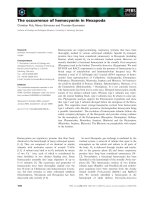
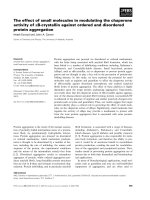
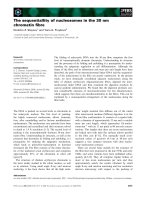
![Tài liệu Báo cáo khoa học: The stereochemistry of benzo[a]pyrene-2¢-deoxyguanosine adducts affects DNA methylation by SssI and HhaI DNA methyltransferases pptx](https://media.store123doc.com/images/document/14/br/gc/medium_Y97X8XlBli.jpg)
